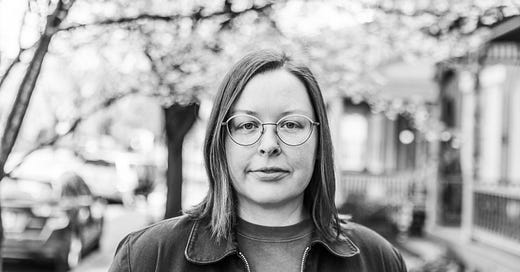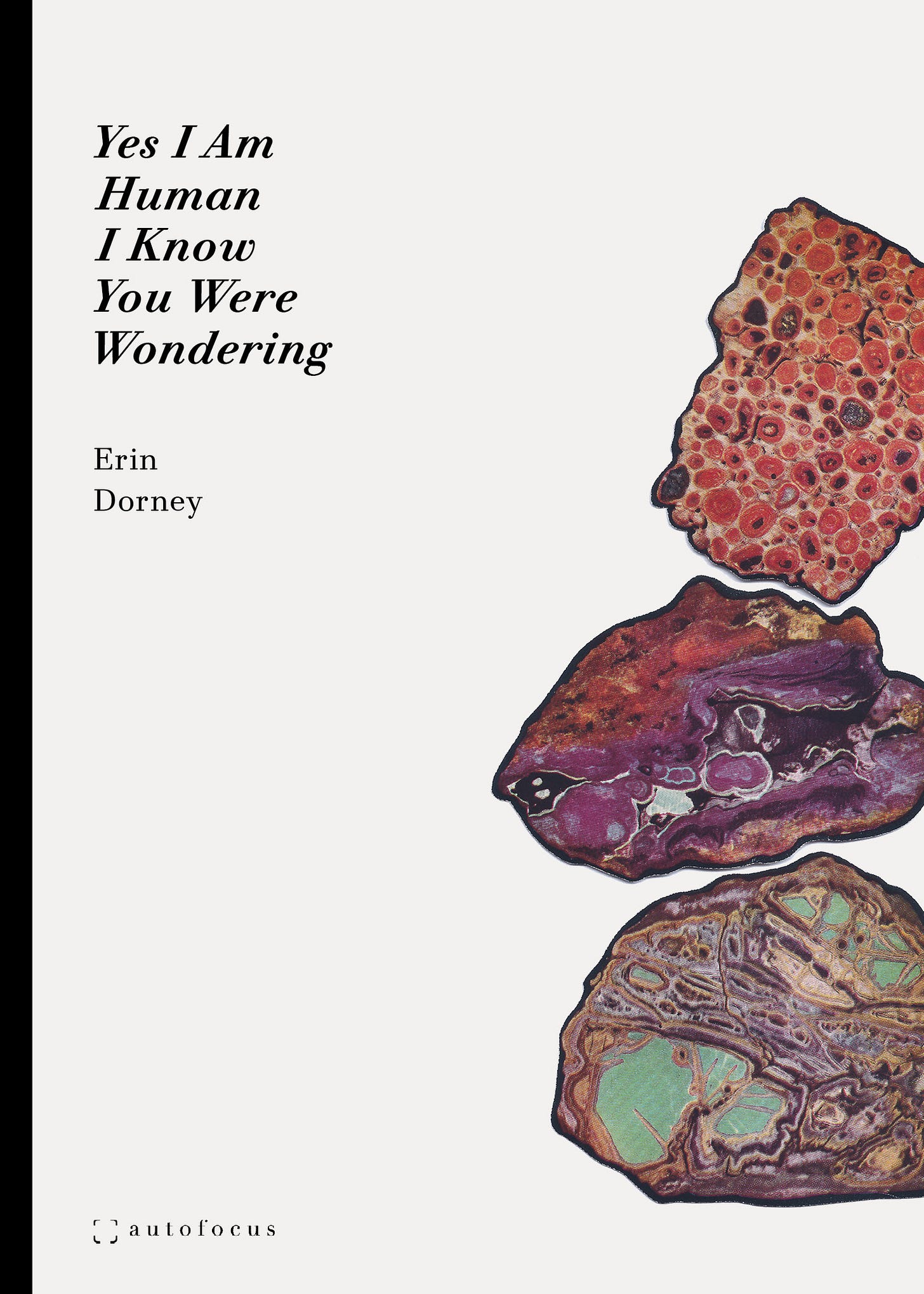The Memoir Land Author Questionnaire #94: Erin Dorney
"At first I thought my book was 'just' poetry. But when pieces started getting picked up by literary journals with a non-fiction focus, I started thinking of it more as autofiction."
Since 2010, in various publications, I’ve interviewed authors—mostly memoirists—about aspects of writing and publishing. Initially I did this for my own edification, as someone who was struggling to find the courage and support to write and publish my memoir. I’m still curious about other authors’ experiences, and I know many of you are, too. So, inspired by the popularity of The Oldster Magazine Questionnaire, I’ve launched The Memoir Land Author Questionnaire.
Here’s the 94th installment, featuring Erin Dorney, author most recently of Yes I Am Human I Know You Were Wondering. -Sari Botton
P.S. Check out all the interviews in The Memoir Land Author Questionnaire series.
Erin Dorney is a poet and artist based in upstate New York. She is the author of Yes I Am Human I Know You Were Wondering (Autofocus Books, March 2025). In addition to books, zines, and literary magazines, Erin’s artwork and installations have been featured at the Center for Maine Contemporary Art, the Minnesota Center for Book Arts, and Susquehanna Art Museum. Learn more at www.erindorney.com.
—
How old are you, and for how long have you been writing?
I’m 40 and I’ve been writing since I was a teenager.
What’s the title of your latest book, and when was it published?
Yes I Am Human I Know You Were Wondering came out March 4, 2025 from Autofocus Books.
What number book is this for you?
This is my second full-length collection. In addition to my first book (I Am Not Famous Anymore: Poems After Shia LaBeouf), I have also published a chapbook (Grating Darling Full of Dirt—erasures of Stephen King’s Pet Sematary), an artist’s book (The Usual Arteries—a single long poem culled from V.C. Andrews’ Flowers In The Attic), and 15 zines.
How do you categorize your book—as a memoir, memoir-in-essays, essay collection, creative nonfiction, graphic memoir, autofiction—and why?
At first I thought my book was “just” poetry. But when pieces from the collection started getting picked up by literary journals with a non-fiction focus, I started thinking of it more as autofiction. Tolka, an Ireland-based literary journal, publishes work that is “formally promiscuous” and which does not always fall into neat categories. They encourage writers to test the creative boundaries of non-fiction. My work felt like a really good fit there, as well as Autofocus Lit (who eventually turned into Autofocus Books, my current publisher). So, I took my cues from the community at the beginning.
What’s the “elevator pitch” for your book?
✅ Epistolary prose poems
✅ Yoga with Adriene/influencer undertones
✅ Image-text collages
✅ Nature & early pandemic isolation
Everyone was online so much, and as I dutifully listened to Adriene Mishler’s voice tell me what to do each day with my body, I found myself in a bit of a parasocial relationship. I resisted it for a long time, determined not to Google her, not to find out about her personal life, not to pry. But I couldn’t stop myself from writing her letters, which of course I never sent, which were actually poems, which is what readers will find in this book.
What’s the back story of this book including your origin story as a writer? How did you become a writer, and how did this book come to be?
On Tuesday, March 24, 2020, my friend Sheila sent me an email with the subject title “Workout plan.” It was just a few weeks after states began ordering shutdowns to stop the spread of the Covid-19 pandemic. At the time I was working in marketing for two independently-owned grocery stores—one in Pennsylvania where I lived at the time, and one in Minnesota. It was incredibly stressful and I had asked my friend for some at home workouts I could use to help with my stress and anxiety. Her plan included a link to Adriene Mishler’s YouTube videos: Yoga with Adriene.
That spring and summer, I tried to keep our grocery stores open, running, and safe, worried, looked at the sky from my postage stamp city backyard, protested, and did Yoga with Adriene videos. Everyone was online so much, and as I dutifully listened to Mishler’s voice tell me what to do each day with my body, I found myself in a bit of a parasocial relationship. I resisted it for a long time, determined not to Google her, not to find out about her personal life, not to pry. But I couldn’t stop myself from writing her letters, which of course I never sent, which were actually poems, which is what readers will find in this book.
What were the hardest aspects of writing this book and getting it published?
I originally submitted this book as a chapbook, with 30 poems. It wasn’t enough for a full-length collection. I was really resistant to adding more epistolary poems, because the 30-day cycle echoes Mishler’s annual 30 Day Yoga Journey, released in January of each year for the past decade (she has retired the series as of January 2025). Autofocus told me they were interested, and then we started brainstorming ways to expand the collection into a full-length.
This actually happened with my first book as well—I submitted my Shia LaBeouf erasure poems as a chapbook and my publisher (Mason Jar Press) asked me to write more poems and expand it. What Michael Wheaton (my publisher at Autofocus) and I landed on was including a series of visual collages to intersperse with the yoga poems. I’ve been doing collage work for a few years now, and the themes worked really well together. That’s how my epistolary chapbook turned into a full-length image-text book.
How did you handle writing about real people in your life? Did you use real or changed names and identifying details? Did you run passages or the whole book by people who appear in the narrative? Did you make changes they requested?
Both of my books use found language from celebrities or influencers. I stick with texts that have been shared with the public, as they are public figures. I think the concept of celebrity is really sticky—I don’t understand it, am often horrified by it, everyone seems to want it. There’s a lot to explore there.
With Yes I Am Human I Know You Were Wondering (the title itself is a phrase from Mishler’s 2021 BREATHE series, Day 3), I was interested in the one-sided relationship I felt with this person I met every day through my computer screen. I used the questions, commands, and offhand remarks from Mishler’s videos as jumping off points—sometimes answering them literally, sometimes using them as a channel to get to some larger or smaller feeling/experience/story.
Although I would welcome a conversation, neither celebrity has been in touch with me regarding these projects. I don’t blame them/and don’t expect it—I know enough about fandom to know that there is some weird and scary shit out there. With parasocial relationships in particular, fans feel they are owed access. I don’t feel I am owed anything—I’m just here to poke around the feelings of it all.
With Yes I Am Human I Know You Were Wondering (the title itself is a phrase from Adriene Mishler’s 2021 BREATHE series, Day 3), I was interested in the one-sided relationship I felt with this person I met every day through my computer screen. I used the questions, commands, and offhand remarks from Mishler’s videos as jumping off points—sometimes answering them literally, sometimes using them as a channel to get to some larger or smaller feeling/experience/story.
Who is another writer you took inspiration from in producing this book? Was it a specific book, or their whole body of work? (Can be more than one writer or book.)
Obviously all of Adriene Mishler’s work. The Hundreds by Lauren Berlant & Kathleen Stewart; The Undying by Anne Boyer; Index Cards by Moyra Davey; and Bleachers by John Grisham (the source text for my collage poems).
What advice would you give to aspiring writers looking to publish a book like yours, who are maybe afraid, or intimidated by the process?
Don’t give up on your projects. Bring them to completion (whatever that means for you) and think about publication later. Short projects are rad, and they can be combined in interesting ways. Don’t treat your writing as a scarce resource—words regenerate.
What do you love about writing?
It’s never-ending.
What frustrates you about writing?
It’s never-ending.
Does your writing practice involve any kind of routine or writing at specific times?
For this book, I would actually practice yoga—do a Yoga With Adriene video—with a notebook next to me, taking notes. Afterwards I would stay on my yoga mat and free write. I’ve continued doing this for the last few years with a writer friend. We do the yoga video separately, then write in the same Google Doc for accountability. If it works, stick with it.
Although I would welcome a conversation, neither celebrity has been in touch with me regarding these projects. I don’t blame them/and don’t expect it—I know enough about fandom to know that there is some weird and scary shit out there. With parasocial relationships in particular, fans feel they are owed access. I don’t feel I am owed anything—I’m just here to poke around the feelings of it all.
Do you engage in any other creative pursuits, professionally or for fun? Are there non-writing activities do you consider to be “writing” or supportive of your process?
Yoga helps me be a better writer. I love searching for interesting old books to turn into erasure poems or cut up for my collages. Zines are so rewarding because you have control of everything, they’re cheap, and folding them is so meditative to me.
What’s next for you? Do you have another book planned, or in the works?
I’m working on a mixed media memoir about the Goo Goo Dolls, a band I had a huge parasocial relationship with as a 90s teen growing up in Western NY. It’s been on the back burner for a while but I think it’s coming back around. It’s another book in the celebrity-studies vein, for sure.







Another book I love and another writer I look forward to reading more from. So excited to see Autofocus Books highlighted this week—they’re publishing such unique and innovative work right now (and just opened for submissions)!